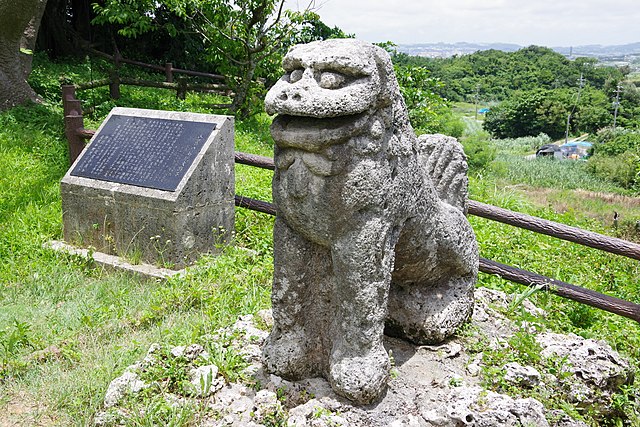Shisa is a traditional Ryukyuan cultural artifact and decoration derived from Chinese guardian lions, often seen in similar pairs, resembling a cross between a lion and a dog, from Okinawan mythology. Shisa are wards, believed to protect from some evils. People place pairs of shisa on their rooftops or flanking the gates to their houses, with the left shisa traditionally having a closed mouth, the right one an open mouth. The open mouth shisa traditionally wards off evil spirits, and the closed mouth shisa keeps good spirits in.
Tomori shisa
A pair of shisa, one with mouth closed
Varieties of shisa (excluding the dragon) at a shop.
Shisa in Nago, Okinawa Prefecture
Chinese guardian lions, or imperial guardian lions, are a traditional Chinese architectural ornament, but the origins lie deep in much older Indian Buddhist traditions. Typically made of stone, they are also known as stone lions or shishi. They are known in colloquial English as lion dogs or foo dogs / fu dogs. The concept, which originated and became popular in Chinese Buddhism, features a pair of highly stylized lions—often one male with a ball which represents the material elements and one female with a cub which represents the element of spirit— that were thought to protect the building from harmful spiritual influences and harmful people that might be a threat. Used in imperial Chinese palaces and tombs, the lions subsequently spread to other parts of Asia including Japan, Korea, the Philippines, Tibet, Thailand, Myanmar, Vietnam, Sri Lanka, India, Nepal, Cambodia, Laos, and Malaysia.
A Ming-era guardian lion in the Forbidden City
A Qing-era guardian lion pair in the Forbidden City. Note the different appearance of the face and details in the decorative items, compared to the earlier Ming version.
Lioness and cubs from the Yuan dynasty discovered inside Peking's city walls
Guardian lions outside the Chinese Museum in Melbourne. In accordance with feng shui, the male lion, with the ball under his right paw, is on the right, and the female, with the cub under her left paw, is on the left.








